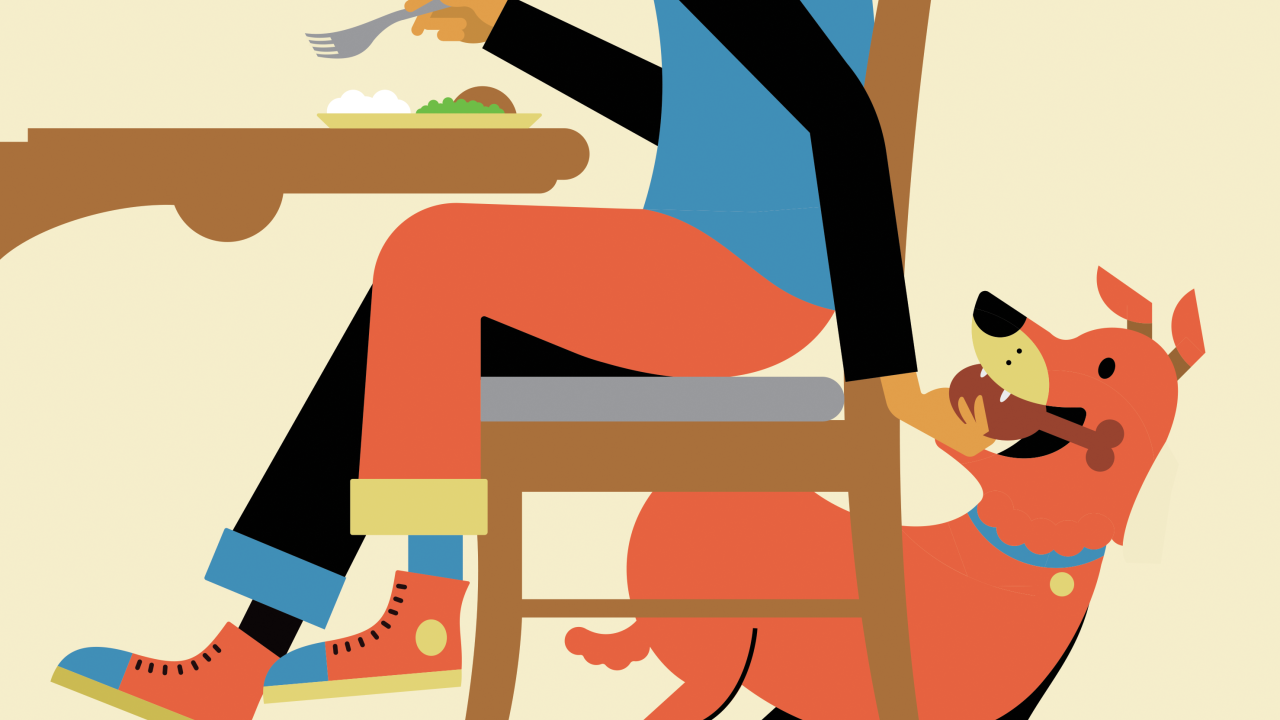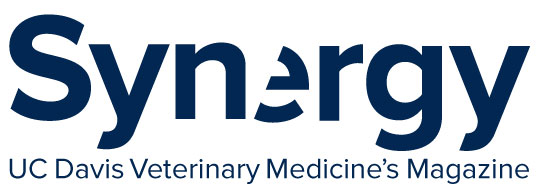

From table scraps to food that falls on the floor, loose garbage can lids, and opportunistic counter surfing, pets have many opportunities to consume “people food.”


piece of pasta slurped up from the kitchen floor is probably not a big deal, but a chocolate bar may necessitate an emergency veterinary visit. So how do you know which “people foods” your pets can consume and which are hazardous to their health? In many cases, a number of variables come into play, from the pet’s size to the amount of the food in question. Dr. Jennifer Larsen, chief of the Nutrition Service at the UC Davis veterinary hospital, provided insight into which foods are safe for pets, which ones may spell trouble, and how owners can keep their pets happy and healthy.
Pets Are Individuals
It is important to note that pets, like people, are individuals. This means a lot of variability in not only what they like to eat, but also in what they can tolerate.
“Some pets can eat different foods at every meal,” Larsen said. “Others are very sensitive and need a prolonged transition between different types of foods.”
Whether they have a sweet tooth or a low tolerance for fatty foods, eating the wrong thing can lead to short- and longterm medical concerns such as diarrhea, vomiting and pancreatitis. Unconventional feeding practices can result in insufficient or imbalanced nutrients and associated health conditions.

Consider the Calories
Calories are just as important to your pet’s diet as they are to your own. The abundant supply of highly nutritious and high-calorie foods and treats, coupled with less active lifestyles in many cases, inevitably result in the storage of excess energy as fat. Overweight pets are at increased risk for developing diseases such as diabetes mellitus, arthritis and breathing problems.
More than 90% of a pet’s daily calories should come from a complete and balanced diet (commercial diet or homecooked diet formulated by a veterinary nutritionist specifically for your pet).
More than 90% of a pet’s daily calories should come from a complete and balanced diet
Additional food items, including treats, should not exceed 10% of the daily caloric intake. Larsen pointed out that calorie-dense human food can exceed the 10% treat allowance quickly, so it is important to ensure these items are only consumed in small quantities. Reference food labels or visit the USDA website for information about the number of calories in specific foods.
Most commercial pet treat products are required to disclose the number of calories on the label. However, the calories in “animal part” treats such as rawhide, jerky and bully sticks are usually unknown and can be highly variable due to size differences. These treats can also be associated with choking hazards, kidney injury, and Salmonella contamination, so it is important to evaluate these factors when choosing pet treats.
It is a good idea to discuss with your veterinarian whether specific treats are appropriate for your individual pet.
Salt is also a concern. High amounts can influence cardiac disease, high blood pressure and kidney disease, or interact with medications
Xylitol and Other Sneaky Ingredients
Aside from the calories in certain foods, you may be surprised to find undesirable ingredients lurking in some recipes. For example, onions are sometimes present in human foods where they may not be expected. In sufficient quantities, these foods can be toxic to pets, causing a low red blood cell count (anemia) and a variety of associated health problems. Salt is also a concern; high amounts can influence cardiac disease, high blood pressure and kidney disease, or interact with compounds such as anti-seizure medications.
Another important ingredient to watch out for is xylitol, also known as wood sugar, birch sugar and birch bark extract. It is a naturally occurring sugar alcohol found in plants, including fruits and vegetables. A food additive approved by the U.S. Food and Drug Administration (FDA), xylitol is often used as a sugar substitute in hard candies, gum, mints, syrup, jams and jellies, baked goods, nut butters and vitamins. Dental care products such as toothpaste and mouthwash, cough syrup, over-the counter medications, sunscreens, cosmetics and other products may also contain xylitol.

Xylitol is quickly absorbed into a dog’s bloodstream, unlike most other mammals, resulting in a rapid insulin release. Dogs that ingest xylitol or xylitol-containing products (even in small amounts) can develop hypoglycemia (low blood sugar levels) and liver damage. The clinical signs of low blood sugar can be mild to severe, ranging from lethargy to seizures and death. Xylitol poisoning has not been reported in cats or other domesticated mammals.
Paws Off
Ingestion of foods containing xylitol is a significant concern for dogs. Other food that your pets should never consume include grapes and raisins, chocolate, foods containing caffeine, and any foods that are going to expand, such as raw dough. Fatty foods such as fish or poultry skin and fatty meats are also of particular concern. Although peanut butter is a popular treat, it is high in fat (and calories) and should only be offered in small amounts.
Although peanut butter is a popular treat, it is high in fat (and calories) and should only be offered in small amounts.
Clearing Up Some Misconceptions
Although there is consensus on the foods just listed, long and sometimes conflicting lists of foods pets can and can’t eat lead to confusion on this topic. For example, Larsen said that many people think that avocados are toxic to dogs. The leaves of the plant are toxic to other species, but dogs can safely consume the flesh of the avocado. Just be sure to avoid the pit since they are a choking hazard.
Top 5 Tips
- Keep treats to 10% or less of pet’s daily caloric intake.
- Beware of hidden ingredients, excess salt and xylitol.
- Don’t offer grapes, raisins, chocolate, or foods containing caffeine or extra fat.
- Be informed about the risk of raw foods due to potential bacterial contamination.
- Understand your pet’s individual sensitivities to various foods.
Found on many do-not-eat lists, garlic can actually be an ingredient in some pet foods and treats. Legally, it can only be added for flavor, and the company is responsible for making sure that it is present in a safe amount. Contact the company directly if you have any concerns about the ingredients in commercial pet foods and treats.
Lastly, it is important to be informed about the risks of raw foods to your pet’s health.
“Any raw animal product is not really safe due to potential contamination with bacteria such as Salmonella, E. coli, Campylobacter, and Listeria,” said Larsen.
Bacterial infection can lead to gastrointestinal illness in pets which can be transmitted to humans.
The FDA and Centers for Disease Control and Prevention advise against the feeding of raw pet foods due to the human health risks. Professional veterinary organizations, including the American Veterinary Medical Association, American Animal Hospital Association and the World Small Animal Veterinary Association Global Nutrition Committee, among many others, provide position statements and consumer information documents that also warn of the significant risks and lack of benefits to actively discourage the use of these diets to protect animal and human health.

What to Do if Your Pet Eats Something Toxic
Despite your best efforts and watchful eye, it only takes a moment for a pet to get into something that they shouldn’t. Remember that every potential toxin is different and may require specific treatment.
“Don’t try to treat a possible toxicity problem at home,” Larsen said. “Don’t try to make your pet vomit. In some cases, it can actually cause more damage.”
Call your veterinarian or poison control center immediately. The sooner your pet receives treatment, the better the chance for a successful outcome.
ASPCA Animal Poison Control Center: 888-426-4435
Pet Poison Helpline: 855-764-7661
